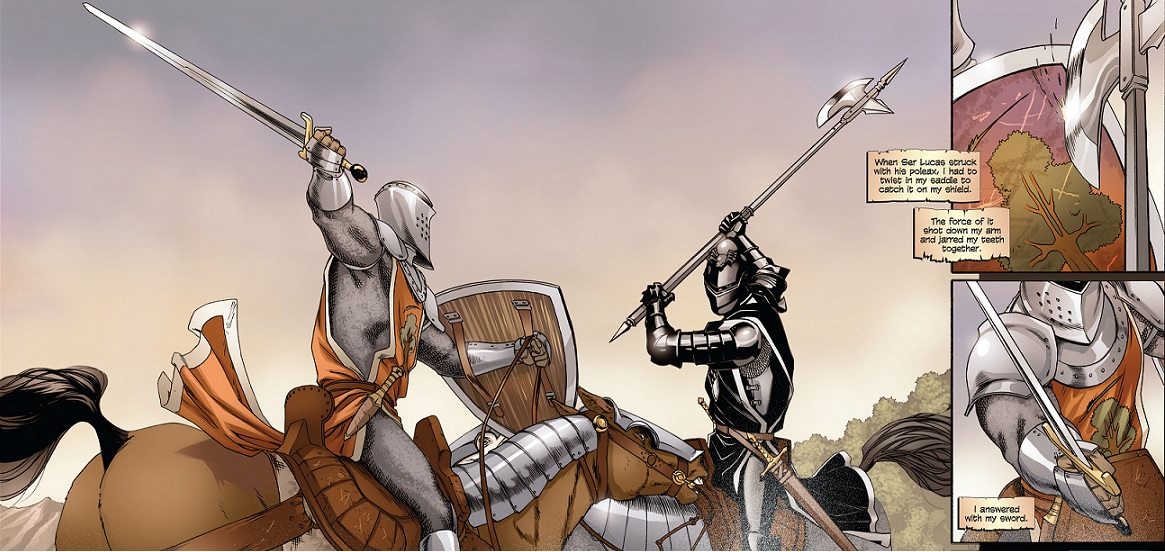It’s almost midnight. The young college students who have gathered to enjoy a weekend of partying at the old cabin in the woods have their fun interrupted when they hear odd sounds coming from outside. They peer out a window, only to see ghastly shapes approaching the cabin. Will any of these students survive the night? Not if the monsters have anything to say about it…
What Is Monster Slaughter?
Monster Slaughter is a tactical game with dice rolling and variable player powers for 2-5 players, ages 14 and up, and takes about 45-60 minutes to play once you know the rules. Because the goal of the game is to kill people, even though it is presented in a lighthearted manner, this is definitely not a game for younger kids. It was originally funded on Kickstarter in 2017 with a retail release the following year. An expansion, Monster Slaughter: Underground, was funded on Kickstarter in 2019 and started shipping to backers at the end of 2020.
Monster Slaughter was designed by Henri Pym and published by Ankama, with illustrations by Edouard Guiton and Thomas Choux. It retails for $89.99, though can be purchased at a discounted price of $66.80 on Amazon.
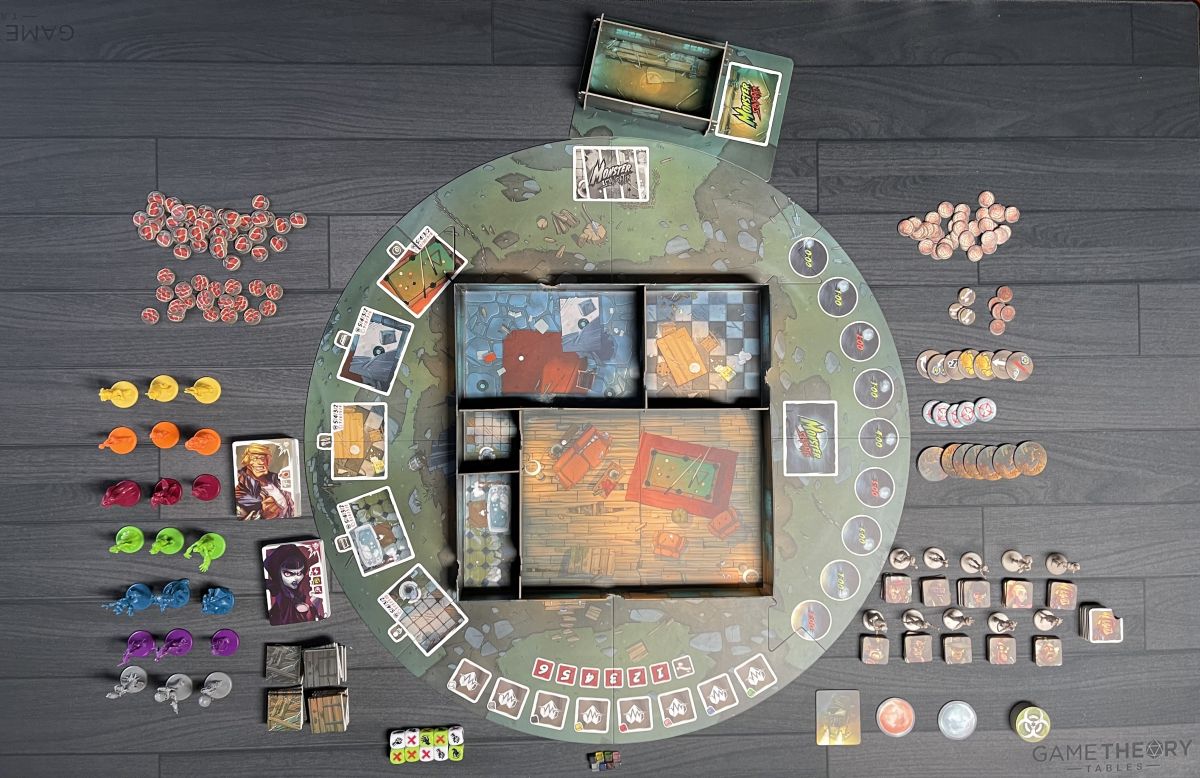
Monster Slaughter Components
The box contains the following:
- 21 Monster miniatures
- 5 Party Guest miniatures
- 5 Surprise Visitor miniatures
- 65 Game cards
- 1 3D Cabin with internal walls
- 4 Outdoor Ground tiles
- 9 Doors
- 5 Barricades
- 5 Reaction dice
- 5 Action dice
- 8 Color Cubes
- 1 Full Moon marker
- 50 Victim markers
- 10 Wound Track Victim markers
- 46 Flesh tokens
- 34 Brain tokens
- 5 Target markers
- 5 Target tokens
- 5 Bone tokens
- 24 Scenario tokens and markers
- Scenario Book
Also included is the Tool Shed expansion, with:
- 3D Tool Shed
- 1 Outdoor Ground tile
- 5 Object cards
- 1 Nocturnal Event card
When I first saw photos of Monster Slaughter, I was blown away by the table presence of the game. Instead of opting for a flat game board, they’ve gone with a three-dimensional cabin to play with. The four walls and floor of the cabin itself are the bottom of the game box:

You simply slot cardboard walls into the box bottom and place the locking Outdoor Ground tiles around the box to complete the game board:
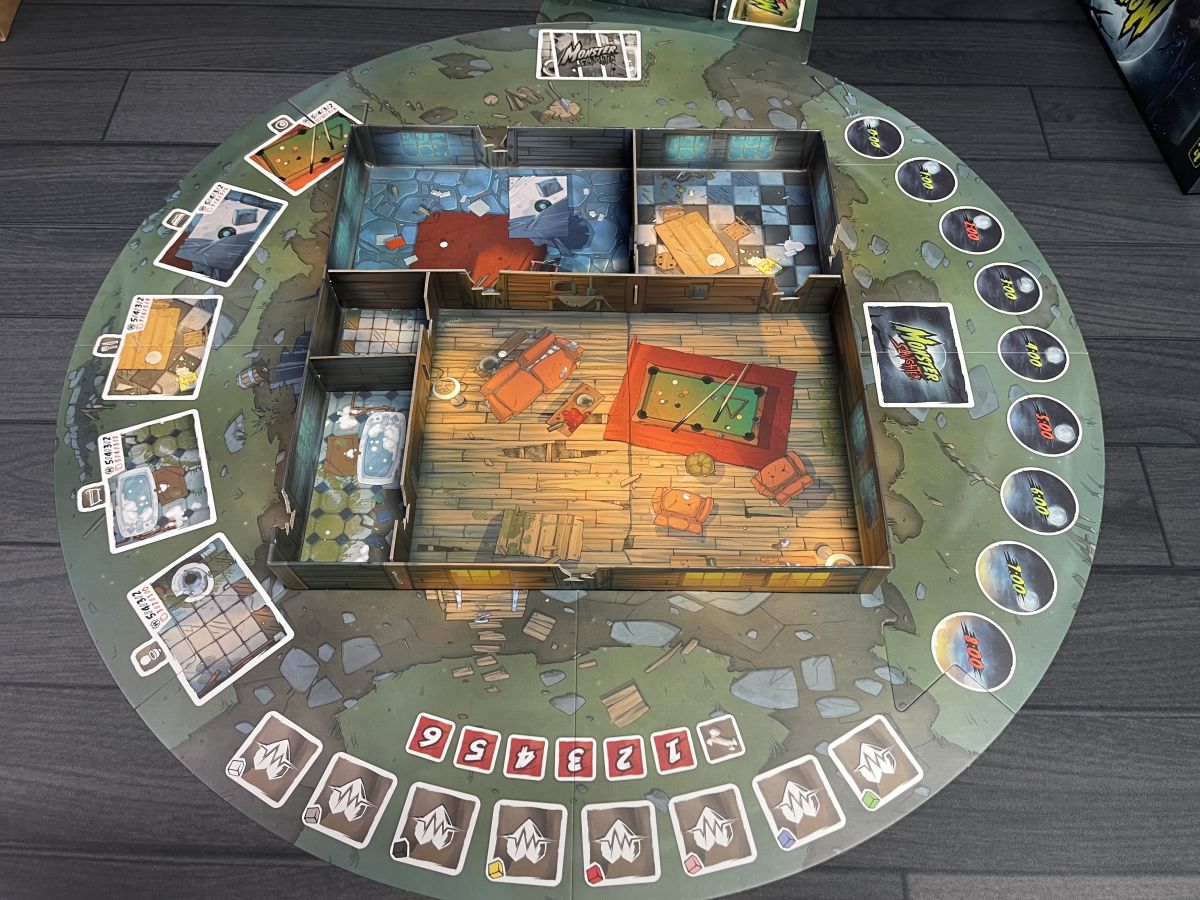
If you are using the Tool Shed expansion, it assembles similarly to the walls of the cabin, and the artwork on its base lines up with the artwork on the top of the game board, so you just place it there.

The terrific artwork has great style, and gives you a “toon” version of a cabin straight out of a horror movie like Evil Dead. If the artwork has a familiar feel to it, then you probably won’t be surprised to find out that artist Edouard Guiton also worked on Zombicide and Massive Darkness for CMON.

The cartoon feel extends right into the artwork on the cards, which are all of a nice linen finish. The Party Guests each fit different horror movie stereotypes: You’ve got the jock, the cheerleader, the smart girl, the nerdy guy, and the stoner. The corresponding miniatures capture the cards’ artwork nicely:

The monsters are also done in the same style as the party guests. Each monster family comes in a different color, and consists of a father, mother, and child. The sculpts are all uniformly good, and you can tell that the designers had a lot of fun with them, especially with the monster children. For example, who knew that werewolf kids(cubs?) ride skateboards?
Even the custom dice feel like they match well with the design aesthetic. There are two different colors: green for the monsters, and white for the humans. The monster dice have claws to show successes on rolls, while the humans have punches for the same.

How to Play Monster Slaughter
You can download a copy of the rulebook here.
The Goal
The goal of Monster Slaughter is to be the family of monsters which causes the most terror and bloodshed by the end of the game.
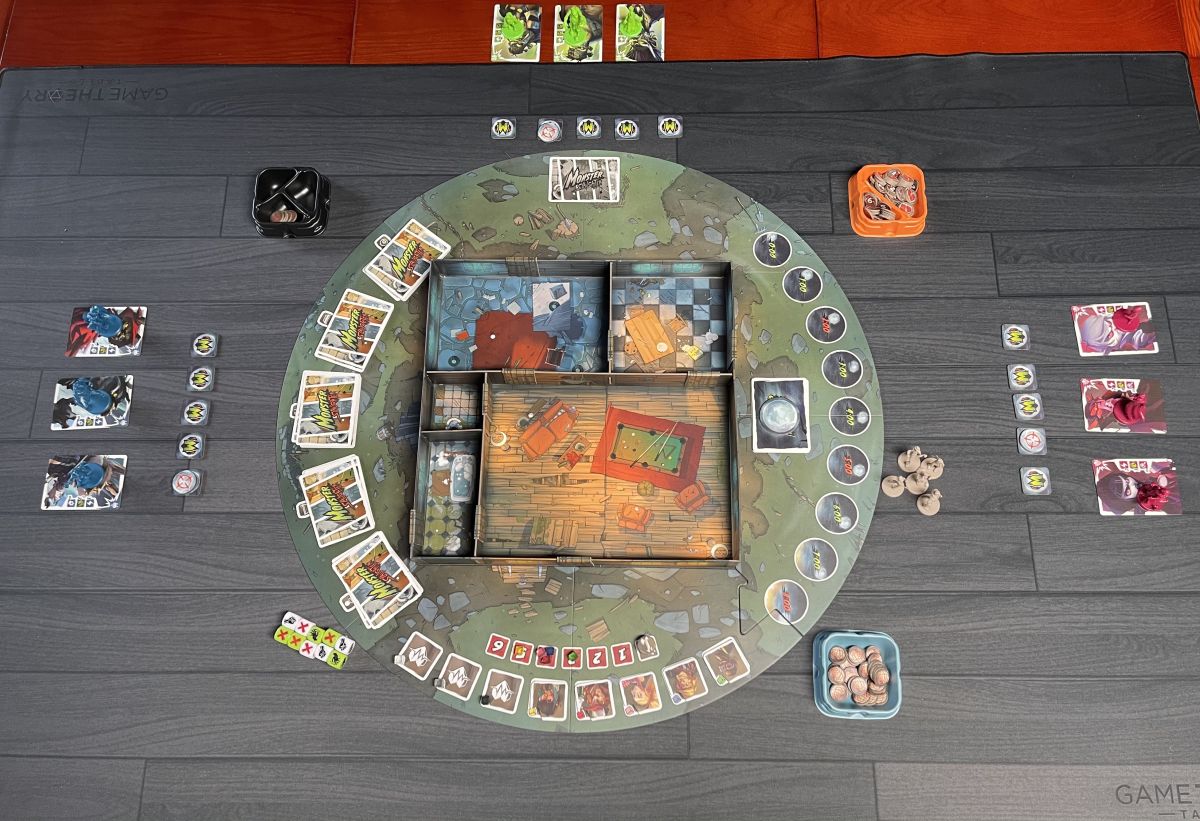
Setup
Build the cabin by adding the interior walls, and then placing the 9 doors over the cracks in the inner and outer walls. Complete the game board by placing the 4 outdoor ground tiles around the cabin.
Next, place the wound track victim markers for each of the 5 party guests on the spaces near the wound track. Place the corresponding color cube on the square of the wound track as indicated by each guest’s card. Place the 5 bone tokens at the end of the wound track.

Place the matching miniatures on their respective markers. Each player then takes one each of the matching victim markers, and 1 target token.
Take the Nocturnal Event cards, and set aside the “Knock Knock” card. Randomly select 7 of the nocturnal event cards, and form a draw pile on the Nocturnal Event card space on the game board. Slip the Knock Knock card into the top three cards of the Nocturnal Event deck.
Place the Full Moon marker on top of the Nocturnal Event deck. Create a supply of Flesh and Brain tokens.
Each player chooses a family of monsters, and takes the 3 character cards and miniatures for the family. Take the Object cards that match the players’ families’ monsters, and combine them with the 3 Trap cards and 7 randomly selected Bonus Action cards to form the Game deck.
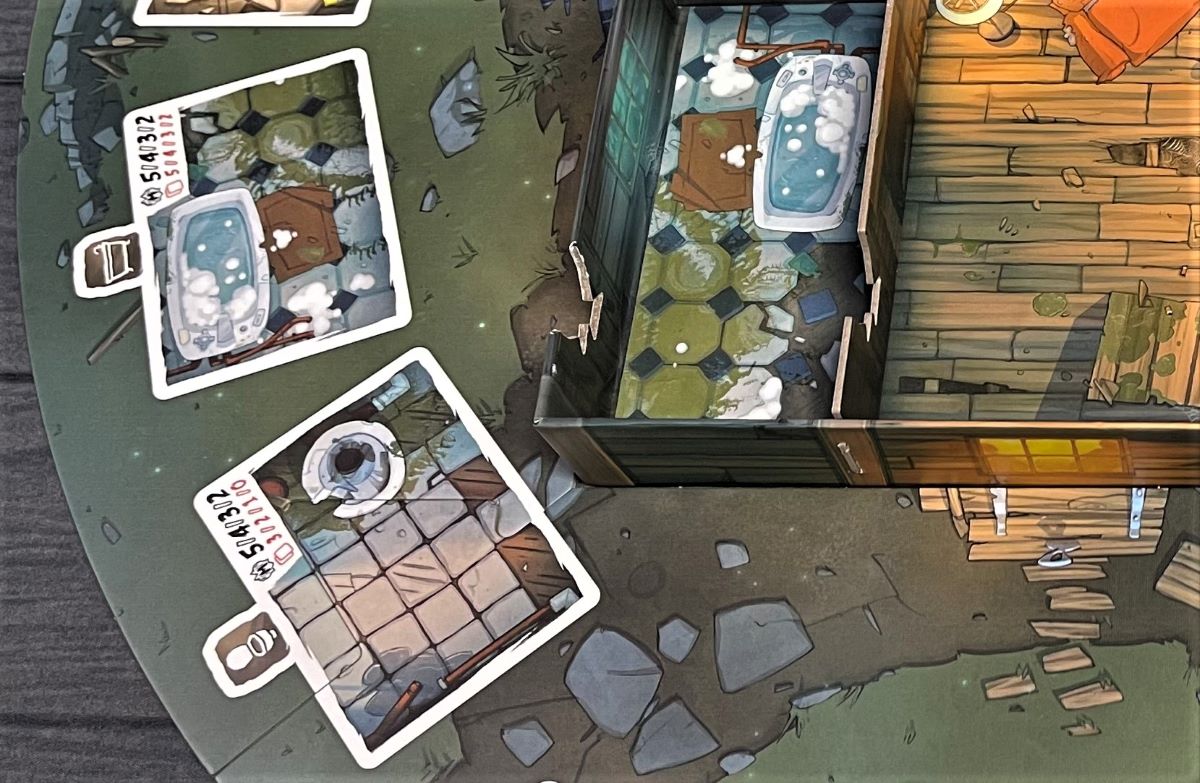
Shuffle the game deck, and then distribute a number of cards facedown to each of the room card spaces on the game board based on how many players there are. The number of cards per player per room are shown on each of the room card pile spaces.
Shuffle the 5 Party Guest cards, and place one facedown on top of each of the room card piles.
Each player takes their 5 Victim markers and places them face down in the order that they’d like to see the Party Guests die. Then they place their Target marker on top of whichever Victim marker they’d like to give the fatal blow to.
Randomly determine who goes first, then start the game.
Gameplay
Turns proceed clockwise, with each player activating just one of their three monsters. The first time you activate a monster, it starts in any one of the four outdoor zones.
No event cards are drawn in the First Round of the game.
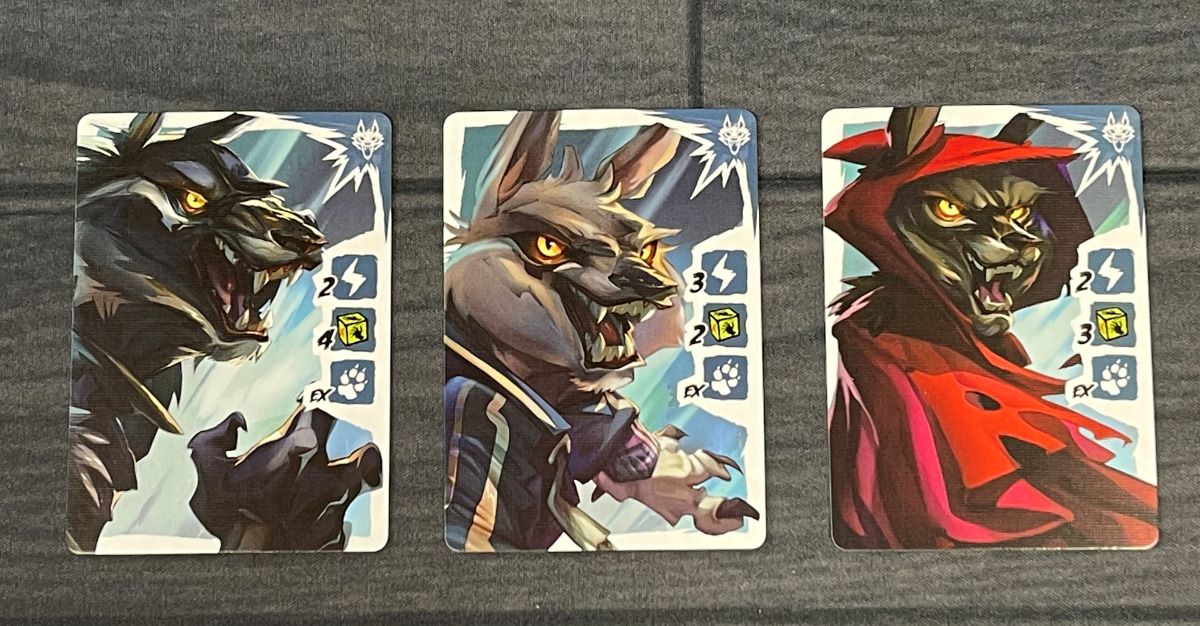
On a player’s turn, monsters get one free move, and can take a number of actions up to the number shown next to the lightning bolt symbol on the particular monster’s card. Every monster family also has a unique special ability, some of which may grant them extra actions. For example, the Werewolves get one additional free move action per turn.
The actions available to every monster are: Move, Peek, Scare, Search, Smash, and Attack. If an action requires dice rolls, the player rolls the number of dice shown on the monster’s card, plus any bonus die that may be provided by a monster family’s special ability.
1. Move
In addition to the 1 free move, players may spend one of their monster’s action points to move from one zone to an adjacent one. Zones are the 5 rooms of the cabin, and the 4 outdoor spaces. You can only move into or through rooms of the cabin if doors between zones have already been smashed.
2. Peek
If the monster is in a room, or adjacent to a room they want to peek in that’s connected by a door, they may peek. To peek, draw the top card of the pile for the room being peeked, look at it without revealing it, then return it to the top of the deck facedown.
3. Scare
If you want to scare a victim, they must be in the same zone or in an adjacent zone that is visible(ie, does not have a closed door).
To scare, roll the number of dice for that particular monster. You may then move that victim a number of zones equal to the successes shown on the action dice. Victims can not leave the cabin except to go to the optionally used Tool Shed.
Whenever a party guest or surprise visitor ends up in a zone without any monsters, they hide. Place their character card back onto the room pile, and shuffle the cards. Place their miniature back onto the Wound track.
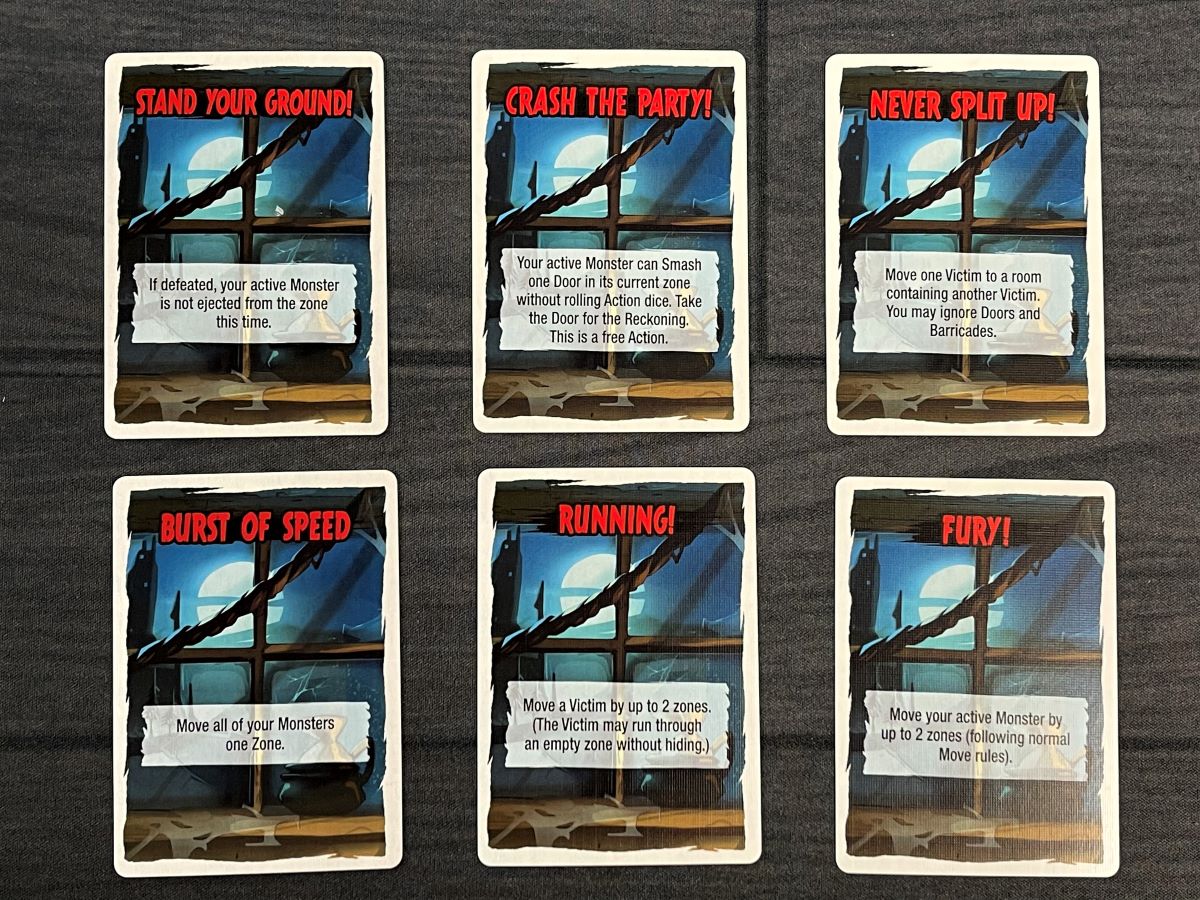
4. Search
If a monster is inside a room, they may search it. Roll the number of dice available for the particular monster. You will then draw, one at a time, one card for each success rolled.
If you draw a Victim on the search, that card is immediately revealed and the matching miniature is placed in the room.
If you draw an Object or Bonus card, those are added to your hand without revealing them.
If you draw a Trap card, reveal the card and follow the card’s instructions.
note: there is a maximum hand limit of 7 cards.
5. Smash
Monsters must smash a door down to move into a room that has a door. To smash, roll the number of dice available for the particular monster. If you have at least one success, the door has been smashed. That player collects the door, which is worth 1 point at the end of the game.
If there is a barricade instead of a door, that will require two successes instead of just one.
Whenever you smash a door, immediately shuffle the draw pile for the room being entered.
6. Attack
If a monster is in the same zone as a victim, they may attack the victim. After declaring an attack, the player gathers the action dice for their active monster. Then, they ask the other players if anyone wants to defend the victim.
Only one other player can contribute a single Object card to help the victim defend themselves. The cards will show how many reaction dice are rolled. If the card has a symbol matching the attacking monster’s family, then one additional reaction die is added to that number. Much like the monsters, each victim also has a unique special ability, which will affect the outcome of the combat in a variety of ways.

The active player rolls their action dice at the same time as another player rolls the reaction dice. Victim successes cancel out monster successes. At the end of the rolls, there are three possible outcomes:
- There are more monster successes than victim successes. The victim is injured, losing as many health points as uncancelled monster successes. Monsters gain one Flesh token for each health point lost in the attack.
- There are more victim successes than monster successes. The monster is ejected from the cabin, smashing through the door if there was a closed door. In this case, the active player does not get to keep a door smashed in this way.
- Tie. Nothing happens.
When a victim loses its last health point, they die and a post mortem is done. The victim’s miniature and corresponding card and pieces are returned to the box.
Post Mortem
- The player who dealt the fatal blow takes as many flesh tokens as health points left before the attack.
- The player who dealt the fatal blow takes a bone token if the victim was a Party Guest.
- If the victim was a Party Guest, each player reveals the Victim marker matching that Guest. If they died in the order a player predicted, then each player who predicted correctly receives a Brain token.
- If the Party Guest was the favorite meal of the monster that dealt the fatal blow, then the active player also receives a Target token.
After you have finished with the monster’s actions for that round, flip that monster’s card face down.
Nocturnal Events
After each player has played their first monster, then the First Player places the Full Moon marker onto the “Midnight” space. They then reveal the top Nocturnal Event card, each of which will change the rules for the following round.

After revealing the Nocturnal Event card, play then continues with each player playing a second monster. After everyone has played their second monster, the First Player moves the Full Moon marker to the next hour(1 AM), and again draws and reveals a new Nocturnal Event card, which replaces the previous one.
Play then continues around the table until everyone has played their third monster. The First Player moves the Full Moon marker again, and draws and reveals a Nocturnal Event card. At this point, everyone flips all three of their monster cards faceup again, and then the cycle repeats. Note: the hour spaces marked in red, like 2 AM, are the ones where all of the players flip their three monster cards faceup.
Game End
If all of the victims are dead before the clock reaches 8am, then the game immediately ends. If the clock reaches 8am with any victims still alive, then every player gets one more round, and then the game ends.
Once the game ends, every player counts up their various tokens, which show the points value on their reverse side. Additionally, any collected doors are worth 1 point. The player with the most points wins.
Tool Shed Expansion
To add the Tool Shed, take 5 Neutral Object cards and form them into a deck which is placed on the Tool Shed’s base. In addition to the Knock Knock card, also slip the “Outta Here” card into the top three cards of the Nocturnal Event deck.
The Tool Shed can hold a maximum of two victims, and changes the rules in the following ways:
- When a victim in the cabin is scared, they automatically enter the Tool Shed if possible. They are visible to the monsters.
- Monsters cannot move into the Tool Shed or search it. They can, however, peek in, scare, and attack the victims inside.
- When scaring a victim in the Tool Shed, the victim automatically cancels one success. If the character is scared, the victim runs back into the cabin and the active player gets to secretly place the victim’s card on top of any room pile.
- When attacking a victim in the cabin, the player to the active player’s right draws a Neutral Object card and uses that to fight back.

Why You Should Play Monster Slaughter
As we’re still in a pandemic, I had to use Tabletop Simulator, an virtual gaming tabletop available through Steam, to play with friends. This was a fan-made module of Monster Slaughter for Tabletop Simulator and not an official one, but all three of us that were playing also own physical copies of the game. I should also note that were we not in a pandemic, I would never play this game on Tabletop Simulator. The programming on the Monster Slaughter module was not anywhere near as good as that of many other board game modules which I’ve played online. Not to mention that this is a game that just begs to be played in person. But, on the other hand, it did allow me to play with someone thousands of miles away in Canada, so there’s that.
Monster Slaughter has a very cinematic feel. The game board is essentially your movie set, and the monsters and victims your actors. For my first game, I chose to play as the Maniac family, who are “so terrifying that it hurts to look at them.” Correspondingly, their special ability is that when they reveal a victim during a search, they automatically give them one wound. My friend Jason played the Werewolves, which get an extra free move, and Mandi played the Mummies, who get a free scare action per turn.
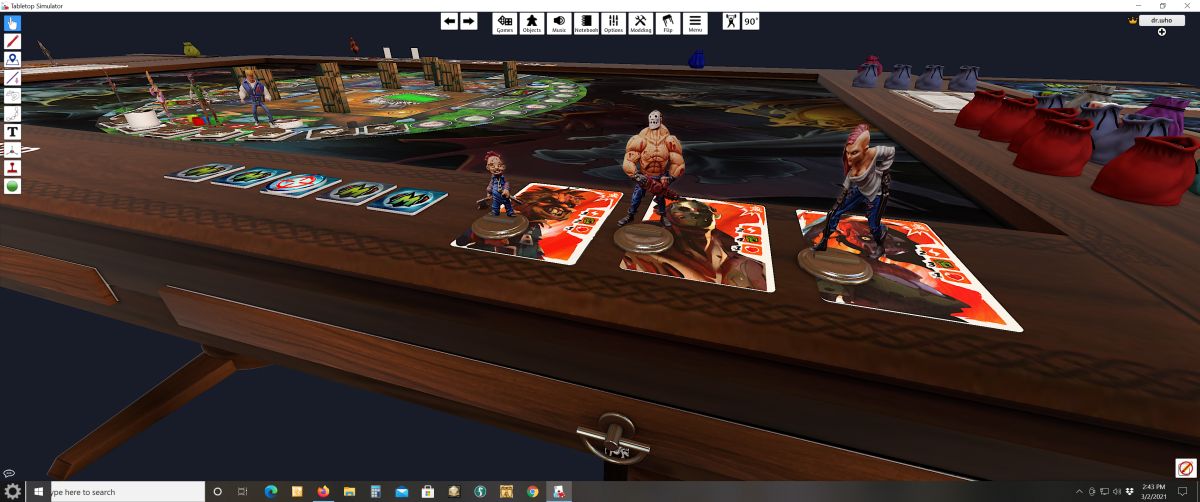
As a horror movie fan, I found myself falling into some playacting during the game. With Papa Maniac’s chainsaw, it was easy to picture him sawing a door into pieces while using the Smash action. I even had a voice that I would use for him, though in hindsight it sounded less like a hockey-mask wearing maniac and more like Michael Keaton in Beetlejuice.
There were a lot of fun, memorable moments throughout the game. While searching in the living room, I was the first player to encounter one of the Trap cards. In this case, it was the Explosion, which effectively ended my turn by throwing me out of the cabin and would require me to burn a move just to get back inside on Papa Maniac’s next activation.

Later, I moved Papa Maniac around to the kitchen to try to take down Bob the jock, as he was next in my predicted victim order. But I wasn’t the only one trying to take him down, as Mandi’s Mummy Mom also had Bob next on her kill list. Bob had already taken a bit of damage, and I figured my powerful Papa Maniac would be able to seal the deal. I attacked, but Bob was left with just one health point. And Bob’s special ability ejected Papa Maniac from the cabin! But Mandi had already activated her Mummy Mom previously. At the end of the round, Bob was still alive…but we had also played all three of our monsters, and now it was time to flip them all face up again. I was the First Player, so I activated Papa Maniac first. No one had any object cards left in their hands for defense, so it was a bit of overkill to roll all 4 of Papa Maniac’s action dice to finish off Bob.
We kept our first game simple as the rulebook suggests, and didn’t use Surprise Guests or the Tool Shed. In that game, we were more often than not smashing down doors, searching the rooms, then trying to kill whoever we found, regardless of how we’d predicted our kill orders.

Both the Tool Shed and Surprise Guests make Monster Slaughter more strategically complex, and you’ll find that you’ll be using the peek and scare actions more frequently. The Surprise Guests have more advanced special abilities than the Party Guests. For example, monsters can’t attack other victims if Officer Roscoe is in the same zone. When setting up the game, you can also choose to use any or all of the Surprise Guests as regular Party Guests, if you want to increase the challenge.
While the game is a little on the pricier side, there’s a lot of value and replayability in the box. In addition to being able to choose from the many different victims and monsters, all with their own special abilities, there’s also a Scenario Book. The book contains 8 different horror-themed scenarios, which you can use to switch up your games. Some of these scenarios are directly inspired by popular horror movies, like “Christa,” which features a vengeful, possessed car. All of these scenarios add or change up rules in the game, and many give different win conditions for the players.
There’s a great sense of humor that pervades the design of the game. Some of the surprise guests will be strikingly familiar, such as Bullwhip Walton, who’s clutching both his whip and an idol, or Prof. Browne, the time-traveling scientist. For fans of horror films, the Object cards are filled with sly references to classic films. The box of vinyl records does more damage to Zombies(a nod to Shaun of the Dead) while the country music recordings will hurt the Aliens more(Mars Attacks). Playing the game, it’s pretty obvious the designers love horror movies.
If you’re a horror movie fan, there’s a lot to love about Monster Slaughter. As I said earlier, this is a game that looks fantastic on your table. I can imagine that if it was being played at a board game convention, it would definitely draw a crowd. The mechanics are fairly straightforward, but you’ll definitely want to be strategic in your gameplay if you’re playing to win. But even if you just want to run around causing havoc as a monster family, that’s fun too. There’s something very satisfying about “flipping the script” on the horror game genre and getting to play as the monsters. And even if you’re not into horror, it’s worth checking out. You might find you enjoy taking vengeance on those annoying, partying students.
Click here to see all our tabletop game reviews.
![]() To subscribe to GeekDad’s tabletop gaming coverage, please copy this link and add it to your RSS reader.
To subscribe to GeekDad’s tabletop gaming coverage, please copy this link and add it to your RSS reader.
Disclosure: GeekDad received a copy of this game for review purposes.



